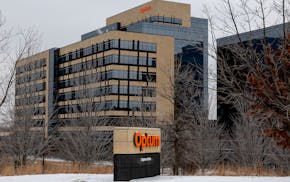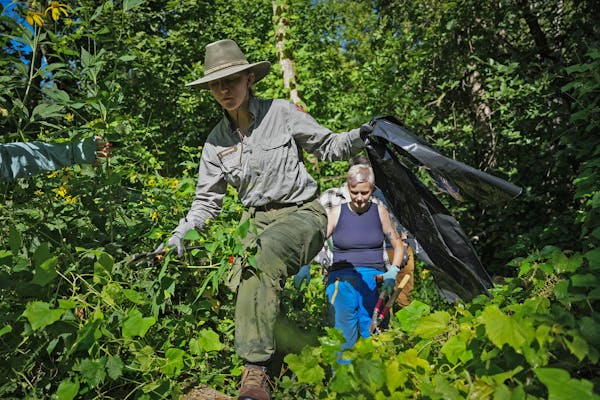Twin Cities gardeners know the drill: Look for plants marked Zone 4 or lower to survive the winter deep cold.
It might be time to reconsider that strategy.
Last week, the U.S. Department of Agriculture released a new hardiness zone map revealing shifts in what plants are considered hardy in Minnesota, including the metro, which is now Zone 5a.
Much of Minnesota has shifted. The previous map, which spanned 1976 to 2005, showed the coldest low temperatures draping across most of Minnesota's border with Canada. In the updated map, however, that cold category (2b, reflecting an average extreme low of 40 degrees below zero) hovers only in a few small pockets near the Iron Range and International Falls.
The shift is even more seismic to the south. The state's veritable banana belt (averaging an annual extreme low temperature of between minus 20 and minus 15 degrees Celsius) used to extend just north of Iowa, around Fairmont and Jackson. Today, that relative warmth stretches north to the Minnesota River and across the southeast portion of the state.
The new hardiness map could broaden opportunities for what gardeners can expect to coax from their fertile soils. Here's what it does — and does not — mean:
What's different about this map compared to the old one?
The new map uses data from more than 13,400 weather stations — significantly more than the roughly 8,000 used to create the last map, released in 2012. That means it's a lot more precise and can put a finer point on microclimates, which are present in every landscape, said Julie Weisenhorn, a University of Minnesota Extension horticulture educator.
"People have been able to try Zone 5 plants and maybe make them grow before this whole map change, but it's because they maybe had the perfect microclimate for that particular plant," Weisenhorn said.
So, there are two new zones for warmer climates. How does this affect me?
Do you grow tropical houseplants? New to the map are Zones 12 and 13, which cover places with average extreme minimum temperatures above 50 and 60 degrees, which includes parts of Hawaii and Puerto Rico. Obviously, it's a lot colder in Minnesota, but these designations could help you decide when to take in your tropical houseplants.
"Open up opportunities'
If your zone changed, you may have more plant options.
"I think it's going to just open up opportunities for people," Weisenhorn said. "People will feel more confident choosing a (Zone) 5a plant than they have maybe in the past."
Still, Weisenhorn said, hardiness zones are just one factor that determine how a plant will do. Light, soil type and drainage, how much space you have and proper care are important, too.
Also critical: Where a plant is planted, said Teri Otterness, the general manager of Highland Nursery in St. Paul. The east side of your house is more protected than the west.
Did climate change drive the zone updates?
Not necessarily. The map reflects the average lowest temperature over the winter in the 30-year period, according to the USDA. As Minnesotans know, those lows can vary quite a bit from year to year.
Measures of climate change, by contrast, typically rely on overall average temperature, not just lows. So while climate change may affect low temperatures, the lows and the averages are different measures, Weisenhorn said.
What are some examples of plants more Minnesotans might consider growing?
Weisenhorn had some ideas. Prized for fall foliage, some varietals of Japanese maple generally grow in Zones 5 through 8.
Another is the oakleaf hydrangea, which has big tufts of flowers and oak-like leaves. It's hardy in Zones 5 through 9.
Boxwoods, too. A few are Zone 4 hardy, but many are designated for at least Zone 5.
Otterness cautioned that there's still a risk in planting Zone 5: The plant might do great for five years and then die in really cold winter.
When in doubt, ask your local garden store. "The internet will tell [people] that they're hardy enough plants, but I know from experience that they're not," she said. "We've been doing it for so long."
What does a zone change mean for my backyard vegetable garden?
Probably not a lot. Most Minnesota backyard fruits and veggies are annuals, Weisenhorn said.
What does the zone mean for farmers?
Also probably not a whole lot — at least immediately.
But Jochum Wiersma, a small-grains specialist with Extension's Northwest Research and Outreach Center in Crookston, said climatologists are also tracking warmer summer night temperatures — which are on the rise.
"Warmer nights spells bad news for cool season grasses," Wiersma said.
Among Minnesota's most iconic cool season grasses: spring wheat.
Wheat, Wiersma said, prefers temperatures around 75 degrees, while corn prefers 85 degrees.
While cash prices on corn are sweeter than wheat, as well, the growing warming trends may further chip away at what once was a wheat empire in the Red River Valley.
Pam Hartwell raises goats and grows hemp in the wooded bluffs near Winona on a farm she grew up on. She's seen longer summers.
"I definitely think it's obviously getting warmer," she said.
And it's not all bad.
"My harvesting date was October 15th," Hartwell said. "If If I could push that to October 30th, I may get more out of my field."
The Minnesota Department of Agriculture's plant zone hardiness page can be found here.
This story has been updated to correct a previous version that misstated the average annual extreme low temperature for USDA hardiness zone 5a.
New type of electric engine powering Graco's latest round of innovation

DOJ urges judge to keep alive whistleblower lawsuit against UnitedHealth Group
![Gas was $2.39 at the BP gas station ay 46th Street at Lyndale in South Minneapolis. ] GLEN STUBBE * gstubbe@startribune.com Friday September 4, 2015 P](https://arc.stimg.co/startribunemedia/4U372WPXFGGQGQHPL2CTC4SFUY.jpg?h=91&w=145&fit=crop&bg=999&crop=faces)
What Minnesotans need to know about Trump's new tariffs
UnitedHealth Group sues tech giant Broadcom over 'exorbitant' price hikes

